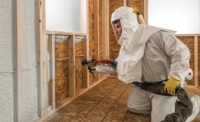Insulation in Concealed Spaces
The benefits of using insulation as passive fire protection in multifamily buildings.






When it comes to designing and building a multifamily structure, building owners and developers are faced with many choices, each with their own unique challenges. One key component and code-regulated decision is addressing fire protection in concealed spaces or the open area between each floor of the building, as required by the National Fire Protection Association. While indoor sprinklers are a common option for fulfilling active fire protection requirements, fiberglass insulation fulfills the same requirements as a passive fire protectant and is a solution growing in popularity due to its ability to deliver additional benefits.
Here are a few factors for building owners to consider when meeting project goals and scope. They should also consult with their architect and builder to determine the best fire protection strategy for concealed spaces.
Added Benefit of Sound Protection
With many residents living in a multifamily structure, tenants expect a certain level of privacy, similar to what they would experience in their own single-unit home. Coupled with requirements laid out in the International Building Code and International Residential Code, developers are required to provide an effective sound barrier between floors, often choosing fiberglass insulation as the solution.
This provides an opportunity to use insulation as both the sound barrier and as a passive fire protectant when placed in the cavity of a concealed space between floors, saving both money and install time. Some fiberglass insulation solutions, such as the formaldehyde-free Cavity-SHIELD from Johns Manville, meet NFPA 13 requirements for limiting potential flame spread between and through floors, which eliminates the need for sprinkler systems. It’s important to note that sound and fire protection have varying requirements for insulation thickness—please refer to local and national building regulations for exact specifications.
Simple Installation
The installation process for fiberglass batts is less time and less labor intensive. Batts are easily installed by simply placing them into the cavity, and fasteners can be used to hold them in place if necessary. Plus, fiberglass batt insulation won’t settle throughout its usage life. Conversely, a sprinkler installation can be a bit more complex as it can involve multiple contractors—like a plumber and fire sprinkler contractor—to set up additional water lines and piping. Additionally, if a pipe bursts or a sprinkler accidentally releases, additional maintenance would be required for any resulting water damage, mold, or other follow-on issues.
Despite a simpler install process, quality installation is key. Consult an insulation contractor to ensure the install job meets NFPA 13 code requirements and does not exceed the maximum air gap of 2 inches (50 millimeters).
Readily Available Materials
Insulation is known to be a readily available material and using this product as passive fire protection in the concealed spaces of multifamily residential buildings can also be significantly more cost effective than installing sprinkler systems. For example, sprinklers can also incur many long-term maintenance costs if a leak or malfunction occurs, which can mean a labor-intensive repair project requiring one or more skilled contractors.
Section 903.2 of IBC specifies the cases in which sprinklers are required in multifamily buildings and this code should be referred to when choosing proper fire protection measures. If insulation is used in concealed spaces between floors, sprinklers will still be required in actual units and common areas.
Every structure has varying needs and builder preferences. When considering if fiberglass insulation is a suitable solution for passive fire protection in the concealed space between floors of multifamily structures, it’s important to understand its benefits and advantages, like acoustical performance, and how it helps meet code requirements. There is no one-size-fits-all approach when it comes to fire protection and all project scopes and components must be considered on a project-by-project basis. W&C
Looking for a reprint of this article?
From high-res PDFs to custom plaques, order your copy today!










